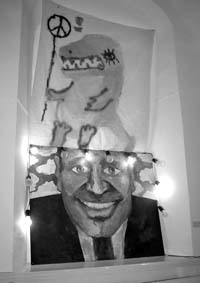An Art Revolution In Full Swing

The Contemporary Art Center at Kyiv Mohyla Academy National University recently featured a young artists’ exhibition entitled Revolutionary Experimental Space.
During the protest rallies on Independence Square, the center invited a group of young artists to use its gallery and facilities as an experimental venue where they could socialize and work together. In these artistic headquarters they painted posters, caricatures, and other kinds of creative works slated for the Khreshchatyk or the Cabinet of Ministers “to support the revolutionary movement.”
Soon the exhibition added essentially artistic works that reflected more general impressions. Not enough time has passed, however, for the artists to portray the revolutionary events in a more fundamental and analytical way.
“This is not documentation of the revolutionary events or propaganda materials, but a diary of the way society behaved in an emergency. The experiment was about the coexistence of many creative processes within a single space during a certain time. The revolution prompted an outpouring of artistic expression. It presented an opportunity to see things from a different perspective and find an ideological and formal platform for a new group of artists,” the artists said.
They gathered from across Ukraine. Volodymyr Kuznetsov, a student from Lviv, excelled in all genres of contemporary art. His video features mechanical toys that move to the cheerful accompaniment of an accordion, forcing the viewer to reflect on whether people are manipulated the same way. Many artists portrayed their concern over the spread of soulless, unfeeling technologies in politics. “The Talking Painting” by Roman Bondarchuk and Maryna Lehchilina is a diorama featuring the infamous tapped conversation about how the elections were rigged, set against the background of a newspaper shot of a man glowing with fake sincerity and surrounded by light bulbs.
In her paintings Zhanna Kadyrova, who makes extensive use of various contemporary techniques, such as comics and placards, stretches the traditional boundaries of art in an attempt to raise public awareness. The obtrusively didactic nature of her composition entitled “Fig.1, Fig.2,” which teaches mudslinging in politics, evokes an emotional response despite its outward serenity. Mykyta Kadan’s series of schematic instructions for physical exercises evoke a similarly contrasting response. Mykyta even added inscriptions in the Georgian language with beautifully ornamented words drawn in ink on orange-colored paper.
Human existence in extreme revolutionary conditions attracted a great deal of attention from the young artists. This aspect of the revolution is reflected in the ode to felt boots — a graffiti diorama by Maryna Makukha — and a roomful of rolled-up mattresses arranged with the skill of an interior designer and complemented with paintings on similar unrolled mattresses (Oleksandr Semenov, Kyiv). Meanwhile, Kseniya Hnylytska ties in the speedy weddings on Independence Square with a popular brand of instant macaroni that take three minutes to cook to produce a successful combination of macaroni labels and canvas paintings. Volodymyr Kuznetsov pictured what a wedding night in a revolutionary tent might have looked like in his dynamic light diorama with lifelike figurines moving in the romantic twinkling of Christmas tree lights.
Many artists portray the image of a new citizen, using bright orange hues that resemble the glow of a hot fire lighting up the darkness of the night, as in the works by Yaroslav Kolomiychuk, Olesia Khomenko (Kyiv), and Dmytro Buhaichuk (Zhytomyr). Meanwhile, the portrait of Yanukovych by Serhiy Siry from Ternopil and the remaining egg-inspired paintings did not mesh with the warm color spectrum and were dominated by cold blue hues, such as the work by Viktor Kharkevych of Kyiv, entitled “Power to bandits, prisons to people.”
The energy released by the revolution materialized in countless aesthetic and civic efforts that verged between art and public protest over the unfolding events. Much of what the artists were creating in the halls of the gallery was spontaneous performance art with gallery visitors acting as the audience.
For one such performance the artists staged an interesting show that involved a group of deaf-mute girls wearing orange gloves and communicating eloquently in sign language, showing remarkable natural expressiveness. Once in a while the gallery halls resounded with revolutionary music — the loud banging noise from metal barrels interspersed with the sound of folk instruments. Who said that art should always be pleasing to the ear and eye?






